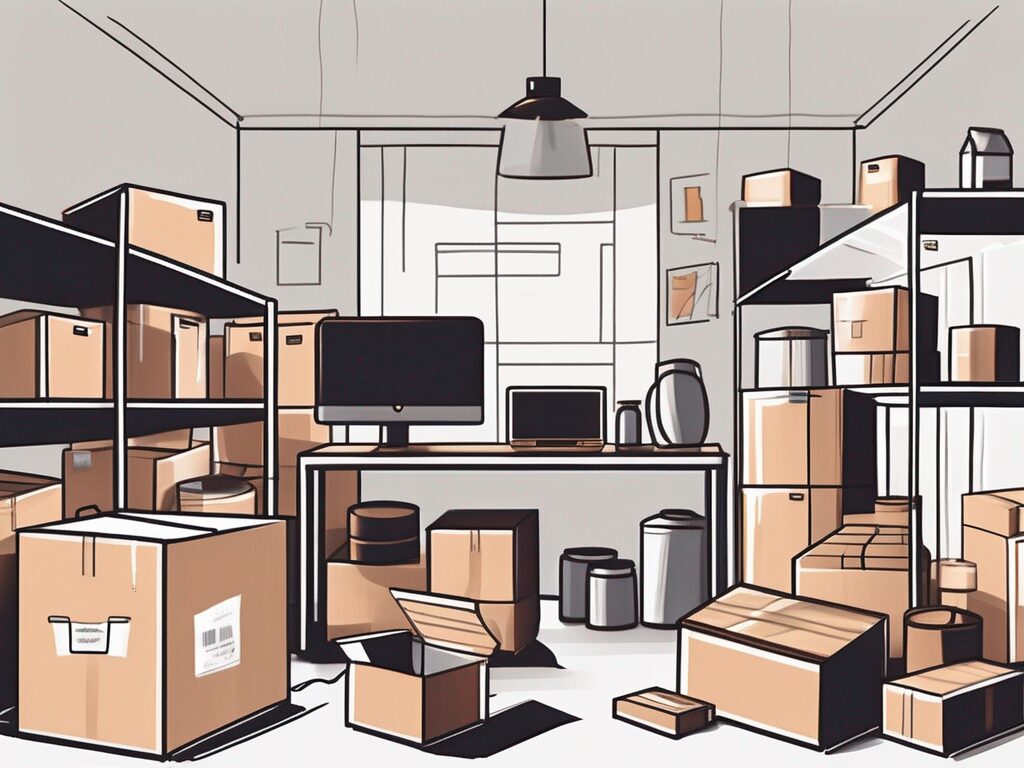
Agent A-Team or Solo Superhero? Finding the Right Real Estate Partner for Your Selling Journey in Wildwood Florida
When it comes to selling your home in Wildwood, Florida,…
January 29, 2024
Moving to a new home is an exciting journey, but it can also be overwhelming. One of the biggest challenges is dealing with all the belongings that have accumulated over the years. As you prepare to embark on this new chapter in your life, it’s essential to consider how to sell your household items effectively. In this comprehensive guide, we will explore the benefits of letting go, the steps to successful downsizing, expert advice for selling everything, and the numerous benefits of clearing out.
Before delving into the practical aspects of selling your household items, it’s important to recognize the positive impact that decluttering can have on your life. Letting go of possessions that no longer serve you not only clears physical space but also creates room for mental and emotional clarity. By streamlining your belongings, you can experience a greater sense of freedom and focus.
When you embark on the journey of decluttering, you are not just tidying up your physical space; you are also decluttering your mind. As you sort through your belongings, you’ll find yourself reflecting on the memories attached to each item. Some items may bring you joy and hold sentimental value, while others may evoke negative emotions or simply take up unnecessary space. By consciously choosing to let go of the items that no longer serve a purpose in your life, you are making room for new experiences and opportunities.
Decluttering is a cathartic process that can bring about a myriad of benefits. From reducing stress and increasing productivity to improving mental well-being, the act of clearing out unnecessary items can transform your living environment and positively impact your daily life. Studies have shown that an organized space leads to a clearer mind, enabling you to make better decisions and find a greater sense of calm.
Imagine waking up in the morning to a clean and clutter-free home. The sense of peace and tranquility that comes from having an organized living space can set the tone for the rest of your day. You’ll find it easier to focus on your tasks and be more productive without the distractions of clutter. Additionally, a decluttered home can reduce stress levels, as you no longer have to spend time searching for misplaced items or feeling overwhelmed by the mess.
When it comes to selling your house, enlisting the help of a reputable real estate agent is crucial. A good agent understands the local market dynamics and can guide you through the process with ease. They will assist you in pricing your property competitively, marketing it effectively, and negotiating offers on your behalf. Take the time to research and interview potential agents to find the one who not only has experience but also understands your unique needs and priorities.
Choosing the right real estate agent is like finding a partner who will support you throughout the selling process. They will listen to your goals and concerns, providing valuable insights and advice to help you make informed decisions. With their expertise, you can navigate the complexities of the real estate market with confidence, ensuring a smooth transition to your next chapter.
Remember, selling your house is not just a transaction; it’s a significant life event. By finding the right real estate agent, you can ensure that this transition is as seamless and stress-free as possible. So, take the time to research and connect with agents who have a proven track record and a genuine passion for helping homeowners like you.
Downsizing is the key to making your move more manageable. By systematically going through your belongings and deciding what to keep and let go, you can create a more streamlined and stress-free transition. The following steps will guide you through the downsizing process.
Begin by assessing your needs and priorities for your new home. Consider the available space, your lifestyle, and any specific requirements. This evaluation will help you determine what items are essential to bring and what can be given away, sold, or donated. Remember, letting go of belongings that no longer serve a purpose can be liberating and create space for new beginnings.
For example, if you’re moving from a large suburban house to a cozy urban apartment, you may need to prioritize furniture that can fit into smaller spaces. Assessing your needs and priorities will help you make informed decisions about what to bring with you and what to leave behind.
Additionally, consider your lifestyle when assessing your needs. If you’re an avid reader, it may be important to bring a selection of your favorite books with you. On the other hand, if you’ve transitioned to e-books and rarely read physical copies, it might be time to donate or sell your book collection.
When it comes to deciding what to keep and what to let go, be mindful of value, functionality, and sentimentality. Evaluate each item and ask yourself if it aligns with your vision for your new home.
Consider the value of each item. Is it something that holds significant monetary value or sentimental value? If not, it may be worth considering letting go of it. Remember, downsizing is an opportunity to curate your belongings and embrace a more minimalist lifestyle.
Functionality is another important factor to consider. If an item no longer serves a purpose in your new home, it may be time to part ways with it. For example, if you’re downsizing from a house with a large backyard to an apartment with no outdoor space, you may not need to bring your gardening tools and equipment.
Sentimental items can be the most challenging to let go of. However, it’s important to remember that memories are not tied to physical objects. Take the time to reflect on the sentimental value of each item and decide if it’s necessary to bring it with you or if it can be preserved in a different way, such as through photographs or digital storage.
Once you have identified the items you wish to part with, it’s time to efficiently distribute them. If you have friends or family members who could benefit from some of your belongings, offer them first.
Consider hosting a yard sale to sell items that still hold value but are no longer needed. This not only helps you declutter but also allows others in your community to find treasures at affordable prices.
Utilizing online platforms is another effective way to sell items that still have value. Websites and apps dedicated to buying and selling used goods make it easy to connect with potential buyers and find new homes for your belongings.
Donating to local charities or organizations is an excellent option for items that are in good condition but may not have significant resale value. Not only does this help those in need, but it also ensures that your items are being put to good use and not contributing to landfill waste.
When selling your household items, it’s essential to provide accurate and detailed descriptions. Take clear photos and include measurements and any relevant information that potential buyers may find helpful.
Organize your items into categories to make it easier for buyers to navigate through your listings. For example, if you’re selling kitchen appliances, group them together and provide a comprehensive description of each item.
Setting reasonable prices is crucial to attract potential buyers. Research similar items online to get an idea of their market value and adjust your prices accordingly. Remember, you want to strike a balance between making a profit and ensuring that your items sell quickly.
Utilize online marketplace platforms or consider consignment stores that specialize in selling gently used furniture and decor. These platforms and stores have a wide reach and can help you connect with buyers who are specifically looking for pre-owned items.
By following these four steps, you can successfully downsize and make your move more manageable. Remember to approach the downsizing process with an open mind and embrace the opportunity to create a more streamlined and stress-free living environment.
Selling your household items before a move requires careful planning and execution. Whether you are selling a house with belongings, contemplating selling “as is,” maximizing profits by selling high-value items, or clearing out a house in a hurry, expert advice can make all the difference.
Selling a house with your belongings presents unique challenges. To ensure a smooth process, it’s essential to declutter and stage your home effectively. Remove personal items to allow potential buyers to envision themselves in the space. Organize and showcase the best features of your home to maximize its appeal and attract interested buyers. Consider utilizing a storage unit to temporarily store excess items during the selling process.
When decluttering, it’s important to be strategic. Start by going through each room and identifying items that you no longer need or want. Separate them into categories such as “sell,” “donate,” or “discard.” This will help you stay organized and make the selling process more efficient.
Once you have identified the items you want to sell, consider different avenues for selling them. Online marketplaces like eBay or Craigslist can be great options for selling smaller items, while hosting a garage sale can help you get rid of larger items. Don’t forget to take high-quality photos and write detailed descriptions to attract potential buyers.
Staging your home is another crucial step in selling a house with belongings. This involves arranging furniture and decor in a way that highlights the best features of each room. Consider hiring a professional stager if you’re unsure how to best showcase your home. Their expertise can help create an inviting atmosphere that appeals to potential buyers.
If you are in a time crunch and need to sell quickly, you may consider selling your house “as is.” This option can be appealing to buyers looking for a fixer-upper or investors seeking opportunities. While you may not achieve the highest possible sale price, selling “as is” can expedite the process and provide a hassle-free transition to your new home.
When selling “as is,” it’s important to be transparent about the condition of your home. Make sure to disclose any known issues or repairs that are needed. This will help manage buyer expectations and avoid potential conflicts down the line. Consider getting a pre-inspection done to identify any hidden problems and address them upfront.
While selling “as is” may require some compromises, it can also save you time and money on repairs and renovations. Focus on highlighting the potential of your home and its location. Emphasize the positive aspects, such as proximity to schools, parks, or public transportation, to attract buyers who are willing to invest in the property.
If you have high-value items in your house, it’s essential to optimize their sale potential. Identify valuable pieces such as antiques, artwork, or collectibles, and consider seeking professional appraisals or consultations. Properly advertise and market these items to attract the right buyers and potentially maximize your profits. Online auction platforms or specialty dealers can be valuable resources for selling high-value items.
When selling high-value items, presentation is key. Take high-quality photographs that showcase the item from different angles and highlight its unique features. Write detailed descriptions that provide information about the item’s history, condition, and any notable characteristics. This will help potential buyers make informed decisions and feel confident in their purchase.
Consider reaching out to relevant collectors or enthusiasts who may have a specific interest in the item you’re selling. Attend local trade shows or exhibitions where you can connect with potential buyers and showcase your high-value items. Networking within the community can often lead to valuable connections and opportunities to sell your items at a premium price.
Clearing out a house in a hurry can be a daunting task, but with proper planning, it can be manageable. Avoid common mistakes such as rushing decisions, failing to properly assess the value of items, or neglecting the documentation and organization of important paperwork. Create a timeline, enlist help from friends or family, and efficiently delegate tasks to ensure a smooth and successful clear-out process.
Start by creating a detailed inventory of all your belongings. This will help you keep track of what needs to be sold, donated, or discarded. As you go through each item, take the time to assess its value. Research similar items online or consult with experts to determine their worth. This will prevent you from selling valuable items for less than they’re worth or discarding something that could have been sold.
When it comes to paperwork, gather all important documents such as contracts, warranties, or receipts and organize them in a secure and easily accessible manner. This will save you time and stress when it comes to finalizing the sale of your house or transferring utilities to your new home.
Enlist the help of friends or family members to speed up the clearing-out process. Delegate tasks based on each person’s strengths and availability. This will not only make the process more efficient but also provide you with emotional support during a potentially stressful time.
Remember to take breaks and pace yourself. Clearing out a house can be physically and emotionally draining, so it’s important to take care of yourself throughout the process. Stay hydrated, eat well, and get enough rest to ensure you have the energy to tackle each task.
By avoiding common mistakes and implementing these strategies, you can successfully sell everything before your move. With careful planning and execution, you’ll be able to maximize profits, attract interested buyers, and ensure a smooth transition to your new home.
Clearing out your household items before moving offers numerous benefits beyond the practical aspects of selling. By parting ways with unneeded possessions, you can generate extra cash to support your move or invest in new items for your new home. Additionally, the process of decluttering can bring about a sense of liberation and freedom.
When you take the time to sort through your belongings, you may come across forgotten treasures that hold sentimental value. These items can be sold to collectors or passed down to family members who will cherish them. Not only will this bring you financial gain, but it will also ensure that these items find new homes where they will be appreciated.
Furthermore, a decluttered living space will create a cleaner and more organized environment. Imagine walking into your new home and being greeted by open, spacious rooms devoid of unnecessary clutter. This not only improves the aesthetics of your living space but also makes it easier to maintain cleanliness and order.
Studies have shown that a clutter-free environment can have a positive impact on your mental and emotional well-being. When your surroundings are free from chaos and excess, you are more likely to experience a sense of calm and tranquility. This newfound peace can contribute to reduced stress levels and improved overall happiness.
As you embark on the journey of selling your household items before moving, remember to embrace the benefits of letting go. It can be challenging to detach from possessions that hold sentimental value or memories, but by focusing on the positive aspects of decluttering, you can make the process easier.
Follow the steps to successful downsizing, starting with creating a plan and timeline. Set aside specific days or weekends dedicated to sorting through different areas of your home. This will help you stay organized and prevent overwhelm. As you go through each item, ask yourself if it is something you truly need or if it brings you joy. If the answer is no, consider selling, donating, or recycling it.
Seeking expert advice can also be beneficial during this process. Professional organizers or downsizing specialists can provide valuable insights and guidance on how to maximize your space and make the most of your belongings. They can help you identify which items are worth selling and how to price them effectively.
Finally, appreciate the positive impact of a cleared-out living space. Not only will it make your move more manageable, but it will also set the stage for a fresh start in your new place. Embrace the opportunity to create a home that reflects your current lifestyle and aspirations.
By being proactive and intentional in this process, you can create a smoother transition to your new home, both physically and emotionally. Remember that clearing out is not just about getting rid of things; it’s about making space for new experiences and possibilities. So, take a deep breath, roll up your sleeves, and embark on this transformative journey.

If you want the Richr team to help you save thousands on your home just book a call.
 Book a call
Book a call